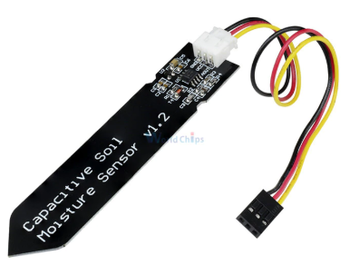SoilHumiditySensor: Difference between revisions
| Line 19: | Line 19: | ||
It got [https://nl.aliexpress.com/item/32882371718.html these capacitive ones] from Aliexpress. | It got [https://nl.aliexpress.com/item/32882371718.html these capacitive ones] from Aliexpress. | ||
I've connected it up as follows: | I've connected it up to a Wemos D1 mini ESP8266 board, as follows: | ||
* probe GND (black) to Wemos D1 mini pin D5 | * probe GND (black) to Wemos D1 mini pin D5 | ||
* probe VCC (red) to Wemos D1 mini pin D0 | * probe VCC (red) to Wemos D1 mini pin D0 | ||
Revision as of 15:47, 12 May 2019
| Project SoilHumiditySensor | |
|---|---|

| |
| Investigation of soil humidity sensors | |
| Status | In progress |
| Contact | bertrik |
| Last Update | 2019-05-12 |
Introduction
A number of types of soil humidity sensors exist. Many have the problem that the electrodes corrode.
For example, see this video by Andreas Spiess that compares a couple of types.
References
Hardware
It got these capacitive ones from Aliexpress.
I've connected it up to a Wemos D1 mini ESP8266 board, as follows:
- probe GND (black) to Wemos D1 mini pin D5
- probe VCC (red) to Wemos D1 mini pin D0
- probe AOUT (yellow) to Wemos D1 mini pin A0
This way, all connections on the Wemos D1 are right next to each other and the wire with the 3-pin connector can simply be plugged into the Wemos D1 mini without having to modify the cable.
The software puts a low level on pin D5 (to emulate GND) and a high level on pin D0 (to emulate VCC). The idea is that the operating current of the probe is low enough for this trick to work.
I put heatshrink wrapping around the top part of the probe, to protect the electronics from moisture.
Software
See my github repository.
The software takes a measurement at a regular interval and sends it over MQTT.